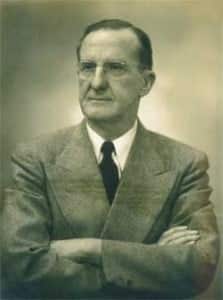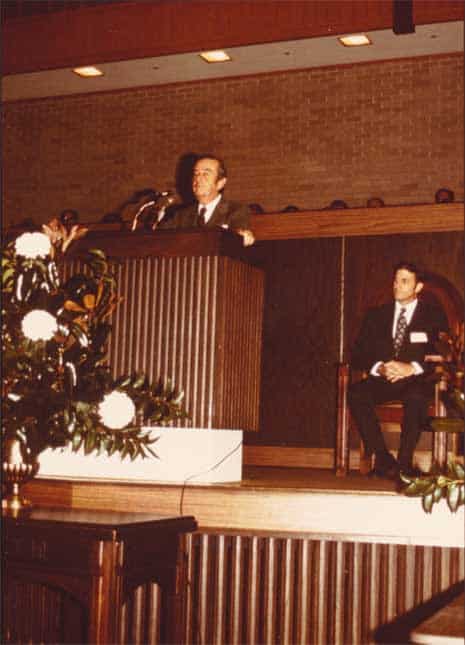This day, January 15, in 1966 marks the death of the Rev. Flournoy Shepperson.
 Flournoy Shepperson was licensed and ordained in July of 1917 by the Ouchita Presbytery of the Presbyterian Church, U.S. His first pastorate was in a yoked ministry to the Presbyterian churches of Magnolia and Mt. Holly, Arkansas, serving there 1908 to 1911. Rev. Shepperson next pastored the Presbyterian church in Monticello, Arkansas from 1911 to 1920, before answering a call to serve Purity Presbyterian church in Chester, South Carolina, from 1921-1925. His last pastorate in the PCUS was with the Second Presbyterian Church of Greenville, SC, which he served from 1925 to 1940. He then withdrew from the Southern Presbyterian denomination and united with the Bible Presbyterian Synod, while his brother David remained within the PCUS. Upon leaving the PCUS, Dr. Shepperson planted a Bible Presbyterian church in Greenville with an initial congregation of 335 members. The church later took the name Augusta Street Presbyterian church, and eventually became part of the PCA, though it was dissolved in 1996. The Augusta Street church was also notable as the original location of the Greenville Presbyterian Theological Seminary.
Flournoy Shepperson was licensed and ordained in July of 1917 by the Ouchita Presbytery of the Presbyterian Church, U.S. His first pastorate was in a yoked ministry to the Presbyterian churches of Magnolia and Mt. Holly, Arkansas, serving there 1908 to 1911. Rev. Shepperson next pastored the Presbyterian church in Monticello, Arkansas from 1911 to 1920, before answering a call to serve Purity Presbyterian church in Chester, South Carolina, from 1921-1925. His last pastorate in the PCUS was with the Second Presbyterian Church of Greenville, SC, which he served from 1925 to 1940. He then withdrew from the Southern Presbyterian denomination and united with the Bible Presbyterian Synod, while his brother David remained within the PCUS. Upon leaving the PCUS, Dr. Shepperson planted a Bible Presbyterian church in Greenville with an initial congregation of 335 members. The church later took the name Augusta Street Presbyterian church, and eventually became part of the PCA, though it was dissolved in 1996. The Augusta Street church was also notable as the original location of the Greenville Presbyterian Theological Seminary.

Oddly, Second Presbyterian of Greenville—the church that Dr. Shepperson left—later became one of the founding churches of the PCA, in 1973, and it was not until 1982 when the Augusta Street church also joined the PCA, as part of the Joining and Receiving of the Reformed Presbyterian Church, Evangelical Synod (RPCES).
From the Memorial read at the 144th RPCES General Synod:
Dr. Shepperson was among those who very early sensed the rising tide of unbelief in his own Presbyterian denomination and took a strong stand against it. It was under his leadership that there was formed a new Presbyterian church in his own city of Greenville, South Carolina, completely separated from apostasy, which church has grown to be one of the largest and most influential churches of our Synod.
Dr. Shepperson was an able and faithful preacher of the Word of God. He possessed a sense of humor that often brightened and enlivened his messages. This he did not lose even in that period of ill health that preceded his death. Many of us can testify to the rich blessing of his ministry from our own pulpits. Those of us who knew him intimately can also testify to his deep devotion to his Lord and to the consequent blessing always experienced in fellowship with him.
We are all aware of the fact that our loss is his great gain. We know that for him to depart this earthly life was to immediately be with Christ, which is far better. We believe that he could honestly echo the words of the great apostle, “to me to live is Christ, and to die is gain.”
Dr. Shepperson had three sons, two of whom entered the ministry, and a daughter. Flournoy Shepperson, Jr. was ordained in the BPC and later came into the RPCES. He pastored churches in Baltimore, Washington, D.C., Pittstown, PA, Savannah, GA, Durham, NC and Tampa, FL. Dr. Shepperson’s son Sam was also ordained in the BPC and later affiliated with the PCA. He had a long pastorate in Arkansas and is now honorably retired. It was Sam who so graciously provided the news clipping and photograph of his father.
Words to Live By: The Church is blessed with many faithful pastors. Sometimes it is easy to focus on the relative few who stray in doctrine or practice, and we forget to praise God for how He works through those who remain faithful and steadfast year after year. We are engaged in a great spiritual battle, and your pastor is on the front lines. Remember to pray for him.



